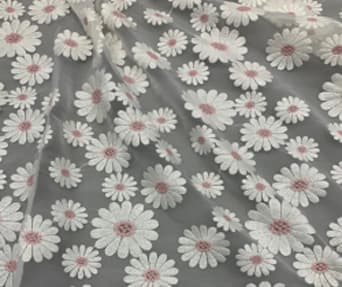Crafting Daisy Embroidery Lace involves a series of intricate processes that require skill, precision, and attention to detail

The process begins with the conceptualization of the lace design. Designers may sketch out various patterns and motifs, considering factors such as the intended application, aesthetic preferences, and current trends in fashion or decor.
High-quality materials are essential for creating exquisite lace. Typically, fine fabrics such as cotton, silk, or synthetic blends are chosen as the base fabric for the lace. Additionally, threads of various thicknesses and colors are selected for the embroidery work.
The chosen lace design is transferred onto the base fabric using methods such as tracing paper, carbon paper, or water-soluble stabilizers. This ensures accuracy in replicating the intricate patterns onto the fabric surface.
Prior to embroidery, the fabric may undergo treatments such as stabilizing or hooping to ensure smooth stitching. Embroidery hoops or frames are often used to stretch the fabric taut, providing a stable surface for the stitching process.
Skilled artisans then meticulously embroider the lace motifs onto the fabric using various stitching techniques such as satin stitch, chain stitch, French knots, and daisy stitch (which lends its name to the lace). These stitches are carefully executed to create intricate patterns and textures.
In some cases, additional elements such as appliqué pieces or layers of lace may be incorporated into the design to add depth and dimensionality to the lacework. This process requires careful placement and stitching to seamlessly integrate these elements into the overall design.
Once the embroidery work is complete, excess fabric or threads are trimmed away, and any remaining stabilizers are removed. The edges of the lace may be finished with techniques such as scalloping, picot edging, or overlocking to prevent fraying and give the lace a polished appearance.
Throughout the crafting process, quality control measures are implemented to ensure consistency and precision in the finished lace. Skilled artisans carefully inspect the lace for any flaws or irregularities, making any necessary adjustments or repairs to maintain high standards of craftsmanship.
Finally, the completed lace is washed to remove any remaining stabilizers or residues and pressed to smooth out wrinkles and enhance the fabric's drape. This step ensures that the lace is clean, crisp, and ready for its intended application.
The finished Daisy Embroidery Lace is carefully packaged to protect it from damage during transit and storage. Depending on the intended use, it may be presented on rolls, folded neatly, or packaged in individual units for sale or distribution.
In summary, crafting Daisy Embroidery Lace is a labor-intensive process that requires skilled artisans to execute a series of precise techniques, from design conceptualization to final finishing. Each step is essential in creating the intricate patterns and delicate textures that characterize this exquisite lace, making it a cherished embellishment in fashion, home decor, and craft projects worldwide.
Embroidered sunflower Lace fabric is a very beautiful Stretch Lace, which is usually used in the design of women's clothing. It consists of lace fabric and embroidered sunflower pattern, which can be used to make various styles of clothing. Nylon lace is usually made of nylon. Embroidery is the process of embroidering patterns or designs on fabrics, which can be done using threads or silk threads of different colors. Embroidered sunflower lace fabrics typically use yellow and green thread or silk threads to complete the details of the sunflower's petals and leaves. The care of Eyelash Lace needs attention to avoid using hot water and strong detergent, it is recommended to use warm water and mild detergent for hand washing.